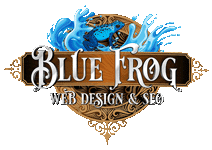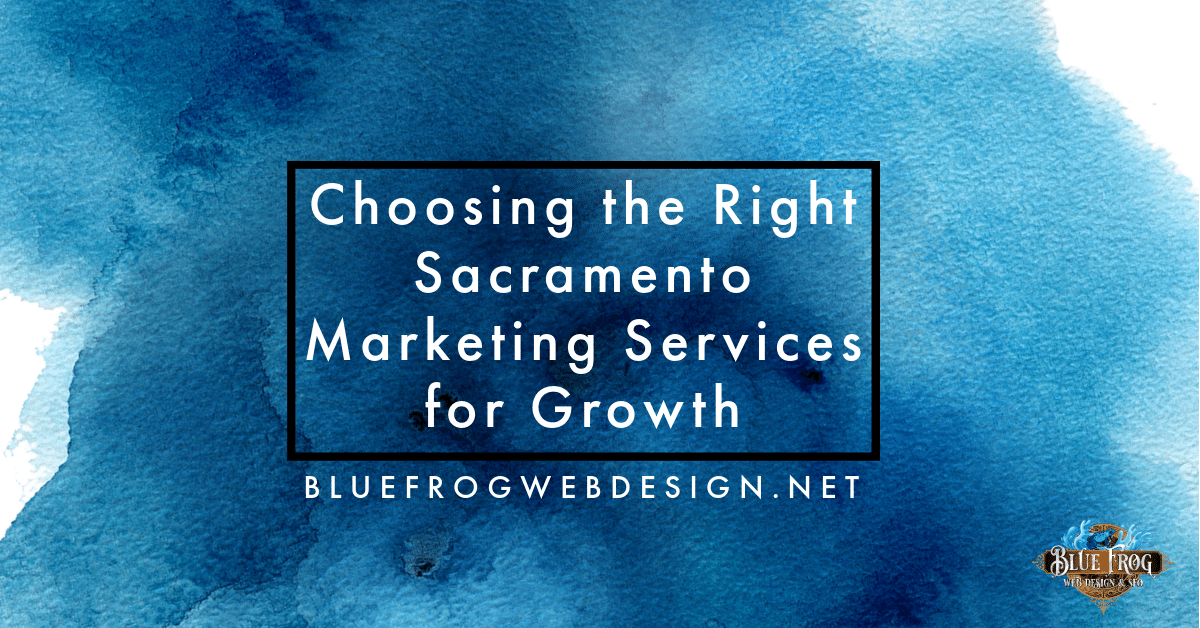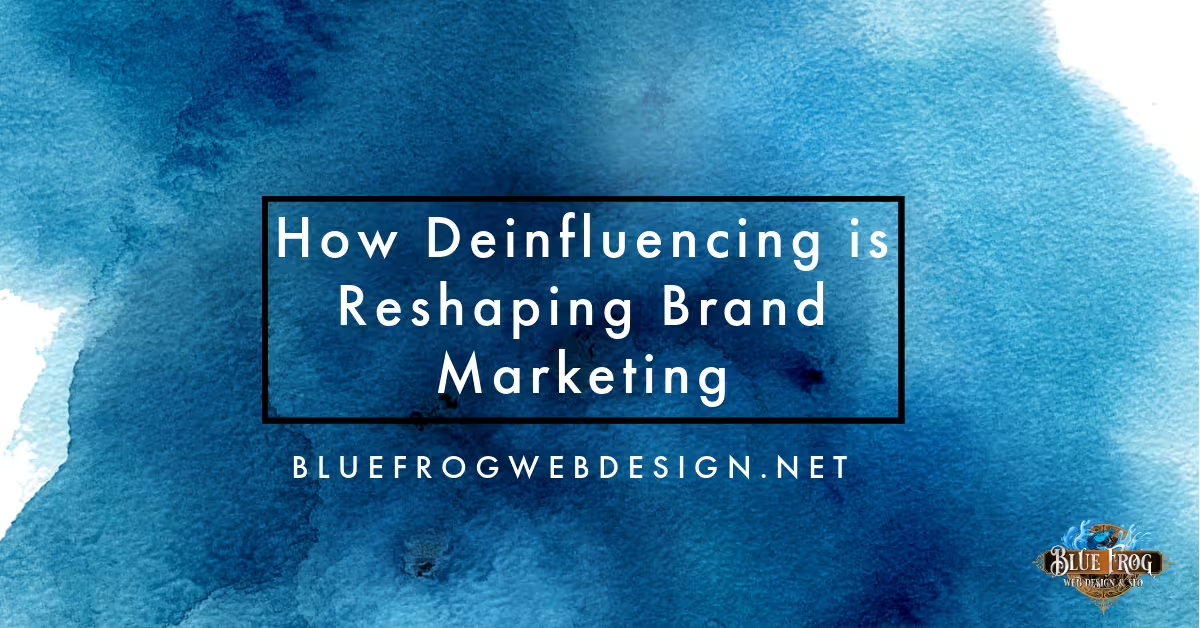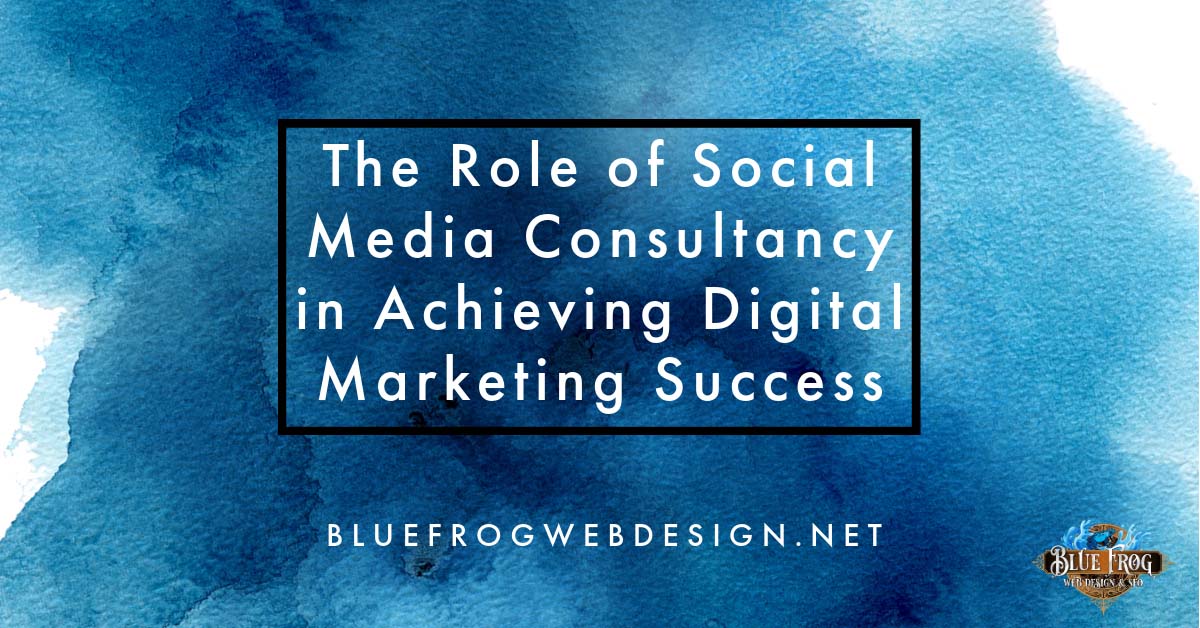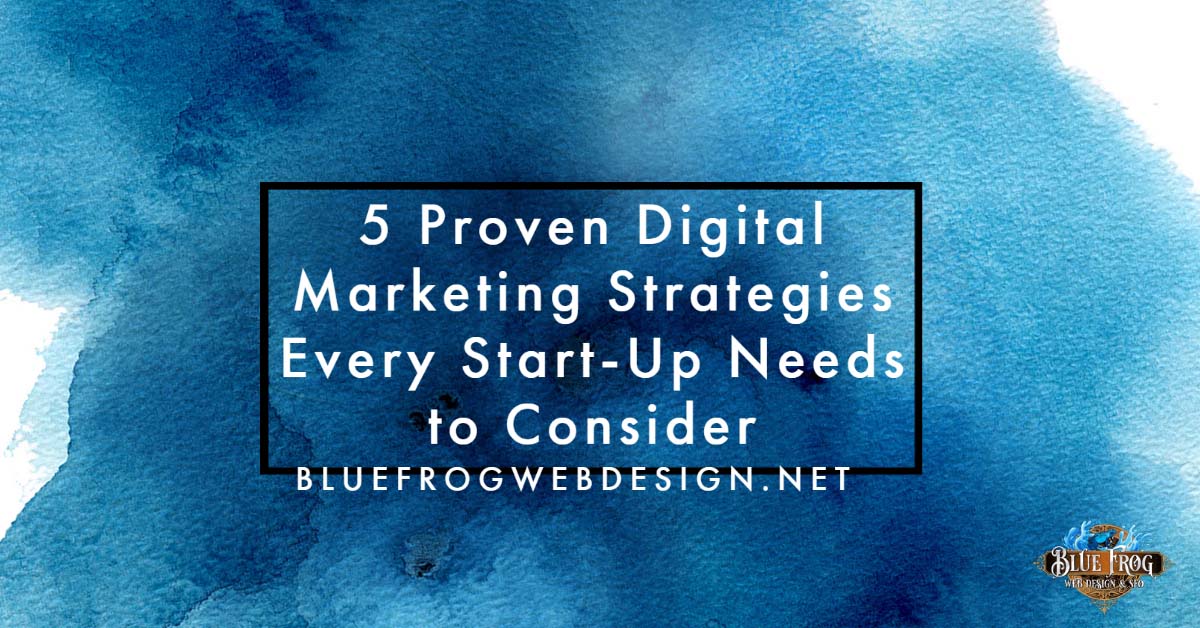Between COVID-19’s strain on physical events and gatherings and the technological advancements marketing has seen, lead generation could only adapt. Indeed, as behavioral and technological trends emerge and dissipate, all 3 customer acquisition phases have had to evolve accordingly. From generation to acquisition and conversion, marketers have to follow new customer journeys – and possess new tools to do so. Thus, let us devote this article to exploring lead generation trends for 2022 that may warrant your attention.
Lead generation vs. lead acquisition vs. lead conversion
Before focusing on lead generation trends specifically, let us briefly distinguish among the 3 aforementioned phases. This will serve two crucial purposes:
- To help distinguish between generation and acquisition, which still sometimes see interchangeable use, and
- to better contextualize why each trend occurs and where it finds use, strict generation aside.
To do so, we may use ActiveProspect’s illustration:
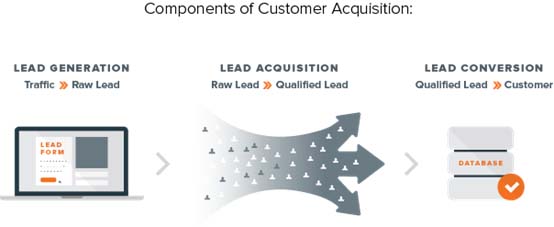
Source: https://activeprospect.com/wp-content/uploads/2017/09/Platform-1.png
Through this illustration, we may define each phase more strictly than simply “acquiring customers”, which each phase builds toward:
- Lead generation comes after traffic generation and refines it into actionable leads. Here, SEO and content marketing will focus on immediate appeal to facilitate discovery and incite consideration.
- Lead acquisition nurtures said leads, following them along their consideration phase. Here, such practices as Landing Page Optimization (LPO) will focus on leveraging social proof for further encouragement.
- Finally, lead conversion finalizes the conversion phase, converting leads into customers. This final phase entails Conversion Rate Optimization (CRO), which will in turn also inform content creation itself.
The holistic, flywheel approach to lead generation
Now, despite this distinction, lead generation trends will often overlap with acquisition and conversion ones. To illustrate this, first consider the example of convertmore.com; despite focusing on CRO, they delve into the entirety of the customer journey. They thus address each stage separately instead of simply following lead generation trends alone.
Then, consider the following illustration by FinancesOnline on lead generation priorities:
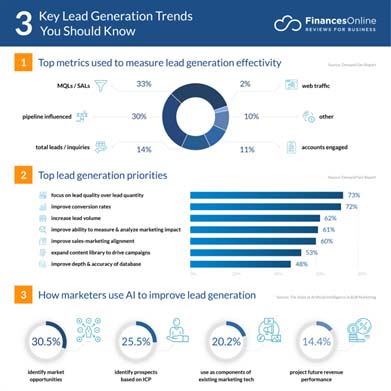
Source: https://s.financesonline.com/uploads/2019/12/lead-generation-trends-1024×1024.png
Here, you will find priorities seemingly unrelated to lead generation as defined above – in the top 3, no less. Specifically:
- Lead quality over quantity (73%)
- Conversion rates (72%)
- Lead volume (62%)
These and similar examples should help lend credence to HubSpot’s flywheel model – or rather, illustrate its necessity. That is, that lead generation cannot function in a vacuum. Rather, it needs to account for the entirety of the customer journey and build toward customer-centric marketing. This is the tenet the following trends embrace as well.
Lead generation trends for 2022: the tried-and-true meet innovation
To prove this point, let us now delve into our main subject; lead generation trends. Initially, innovative practices that are, to some extent, likely to affect marketing include:
- Chatbots continue to see use, and UserLike finds users gradually warming up to them. They do offer operational benefits, such as reduced customer support and service costs, but they still don’t fully satisfy visitors. Thus, while chatbots will continue to see use, as visitors expect them as an option, they may not revolutionize lead generation just yet.
- Video conferencing. Similarly, video conferencing also sees more widespread adoption, especially in the post-COVID-19 era. TrustRadius finds very notable benefits for B2B businesses, as well as a rapidly expanding overall market. Still, this technology only now starts to truly delve into lead generation, and won’t likely bear staggering fruits in 2022.
- Artificial Intelligence (AI). Finally, AI arguably embodies the most coveted digital marketing breakthrough. Indeed, Statista finds a vast array of AI use in marketing, from email marketing to sales forecasts, data analysis, and more. However, AI largely remains a supplement to existing strategies – which are too numerous and case-bound to thoroughly explore here.
Thus, notable as they might be, these practices still see challenges – enough so to not warrant potential groundbreaking status. Therefore, in this article, we may focus on tried-and-true lead generation practices that see organic evolutions instead.
Here, the 2 likely undisputed cornerstones of lead generation are SEO and social media marketing.
#1 Search Engine Optimization
Search Engine Optimization (SEO) is far from a new asset in marketers’ arsenals. By aligning pages and content with search engine ranking criteria, it enhances online visibility – addressing lead volume.
However, in much the same way as SEO has started embracing image search optimization, so too must it delve deeper into local search, through local SEO and voice search.
Local search
Initially, lead generation trends for 2021 have already highlighted the increasing prominence of local search. 99firms consolidates some of the most notable findings in this area in the following:
- “Approximately 46% of all searches include location.
- Roughly 97% of people who use online search look for local businesses.
- 28% of local searches result in a purchase.”
These by themselves may already be actionable, especially for local businesses recovering from COVID-19. However, local search also closely aligns with mobile search, a prominent SEO focus already, and voice search:
- “Some 76% of consumers use voice search to look for local businesses at least once weekly.
- Approximately 78% of mobile local searches prompt an offline purchase.”
Thus, these SEO elements are highly likely to continue to converge in 2022 and beyond.
Voice search
Moreover, and likely more notably, voice search in itself also continues to experience exponential growth. The above findings aside, Statista finds that voice assistants will reach 6.41 billion in 2022, from 5.11 this year. What’s more, they will surpass the world’s population as early as 2023.
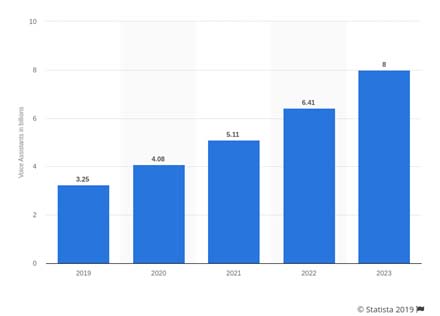
Source: https://www.webmontreal.net/wp-content/uploads/2020/11/digital-voice-assistants-worldwide-use-statista.png
Combined with the above, and the surging popularity voice search sees in such markets as the US, voice search is also highly likely to play a more crucial role in lead generation.
#2 Social media marketing
Similarly, social media marketing remains an extremely potent lead generation and acquisition practice. In fact, as omni-channel marketing continues to yield results, the vast majority of marketers hardly consider overlooking it.
As regards social media marketing, then, lead generation trends seem to highlight two distinct practices of note. Namely, influencer marketing and cause marketing.
Influencer marketing
Initially, influencer marketing is showing no signs of diminishing returns. On the contrary, GrandViewResearch finds that it is forecast to grow more rapidly in the US:
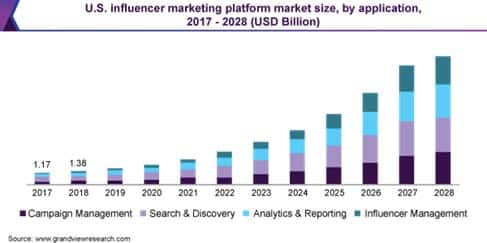
Source: https://www.grandviewresearch.com/static/img/research/us-influencer-marketing-platform-market.png
There are, of course, a plethora of likely reasons behind this surge. Among them, we may find perceived authenticity and marketing humanization, as customers increasingly value recommendations by their peers. Especially in tandem with the increasing effectiveness of video marketing, influencer marketing will likely continue to dominate lead generation trends for 2022.
Cause marketing
Similarly, cause marketing both aligns with influencer marketing and continues to demonstrate standalone merit. Here, lead generation must account for increasingly skeptical audiences – the same ones that require influencer marketing to begin with.
For one, the generational divide in this regard is crucial, as WebsiteMagazine visualizes it, citing AdWeek:
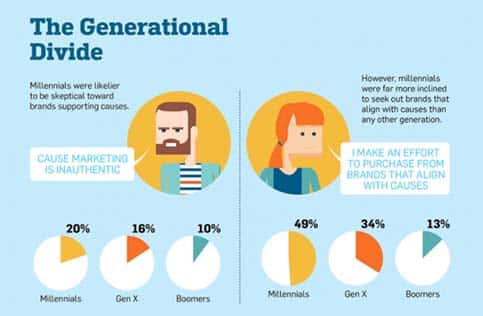
Source: https://www.websitemagazine.com/images/default-source/default-album/cause-marketing.png?sfvrsn=0
It is this generational divide and distrust that marketing on the whole, from lead generation to conversion, now seeks to address. In turn, cause marketing continues to become a valuable asset in this regard, both as a branding tool and a retention factor.
The Edelman Trust Barometer identifies the foundations for this need, finding that ethical drivers are 3x as valuable as perceived competence to company trust. This may not make the case for cause marketing in itself, but the 2021 report’s findings did, identifying societal issues and problems as a desirable cause for CEOs to rally against:
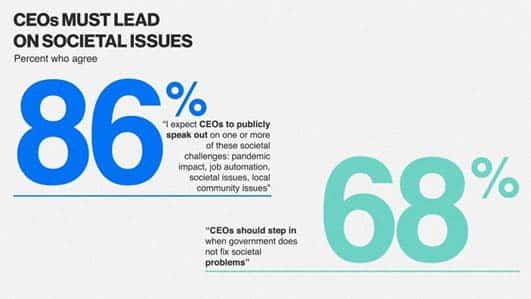
Source: https://c3c5e8m9.stackpathcdn.com/sites/g/files/aatuss191/files/inline-images/CEOs_0.gif
Therefore, while cause marketing may indeed warrant a careful approach, it too is set to inform lead generation trends in 2022.
Conclusion
To summarize, there is a vast array of technological advancements and behavioral shifts alike that will inform lead generation trends in 2022. Where chatbots, AI, and video conferencing offer innovation, SEO delves deeper into local search and voice search. Similarly, social media marketing embraces influencer marketing and cause marketing, as it strives to entice skeptical audiences. Thus, we may safely assume that marketing will continue to innovate and refine tried-and-true practices in 2022, as it seeks to fully realize the flywheel model and enhance the entirety of the customer journey.
Need help with your marketing?
Let my team help you like we’ve helped lots of other businesses dominate their rankings and attract better-quality leads.
